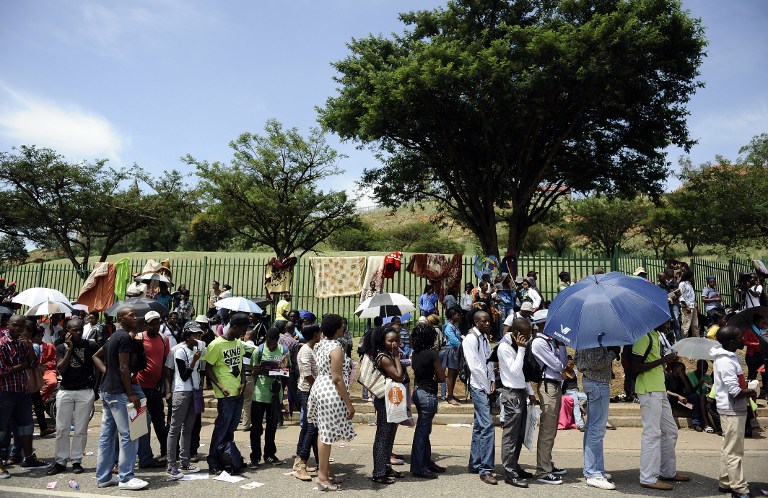This article is more than 8 years old
In June the South African government approved a new National Youth Policy that will be implemented until 2020. The policy (with the tag line “We don’t want a hand-out, we want a hand up!”) outlines the problems facing South African youth and suggests policy interventions.
Africa Check investigated some of the key claims made in the policy document about youth unemployment and education in South Africa.
Unemployment
 The quarterly labour force survey is carried out four times a year in South Africa. Researchers visit 30,000 households in all areas of the country to ensure that their findings are representative of South Africa as a whole.
The quarterly labour force survey is carried out four times a year in South Africa. Researchers visit 30,000 households in all areas of the country to ensure that their findings are representative of South Africa as a whole.For the quarter of April to June 2014, the survey reported 9.4 million people in the age group 15 to 34. Of those people, 3.4 million were unemployed according to the so-called “narrow definition”; in other words they didn’t have a job but were actively looking for one. This represents 36.1% of the labour force in this age group.
The labour force survey for January to March 2015 reported a fraction more people aged 15 to 34 (36.9%) were unemployed.
The “labour absorption rate” refers to the percentage of people in a certain group who are employed. The labour force survey for the second quarter of 2014 found that 30.8% of people aged 15 to 34 were employed; others were unemployed, in education or training, or not seeking employment for other reasons. For comparison, 62.8% of people aged 35 to 44 were found to be employed.
The rate increased to 31.7% in the first quarter of this year.
The labour market dynamics survey measures changes and trends in the labour market. We couldn’t find a reference to the figure of 34.5% in the latest version - dating back to 2013.
Instead, it showed an even higher share: 41% of women between the ages of 14 to 35 were neither employed nor attending schools, universities or colleges, compared to 31.6% of men.
 The quarterly labour force survey for the first three months of this year estimated that there were 3.7 million unemployed young people between the ages of 15 and 34.
The quarterly labour force survey for the first three months of this year estimated that there were 3.7 million unemployed young people between the ages of 15 and 34.Stats SA figures show that 50.6% of unemployed people aged 15 to 34 in this time period had never worked. The highest it has been in recent years was 57.3% in April to June of 2011.
A Stats SA report on long-term unemployment estimated that in 2014 two-thirds of young people (65.8%) had been “unemployed, available for work, and looking for a job for one year or longer”.
In this year’s State of the Nation address, President Jacob Zuma said that the employment tax incentive had been claimed for 270,000 young people. But whether “young workers” (be it 216,000 or 270,000) have been “created” has been questioned by researchers.
This employment tax incentive came into effect at the start of 2014 and is scheduled to end on 31 December 2016. It is meant to encourage employers to hire new, young or less experienced people between the ages of 18 and 29 by giving companies a tax break when they do.
The Southern Africa Labour and Development Research Unit at the University of Cape Town studied the effect of the incentive in the first six months of 2014. They found that it “did not have any statistically significant and positive effects on youth employment probabilities” during this time.
Discussing the findings, co-author of the study and associate professor Vimal Ranchhod pointed out that although employers may be claiming tax relief for employees this did not necessarily mean new jobs or workers were created between January and June 2014.
Ranchhod said that a portion of those young people would have been employed without the introduction of the incentive. In those cases, employers would receive tax relief for people that they would have employed normally.
Education
 As Africa Check has said before, making international comparisons of educational outcomes is complex. Comparisons can only be drawn if representative groups of pupils in different countries take part in standardised testing.
As Africa Check has said before, making international comparisons of educational outcomes is complex. Comparisons can only be drawn if representative groups of pupils in different countries take part in standardised testing.The Southern and Eastern Africa Consortium for Monitoring Educational Quality (SACMEQ) is an international non-profit organisation which undertakes education policy research. It is made up of 15 education ministries from South Africa and its neighbours Botswana, Lesotho, Swaziland, Namibia, Mozambique and Zimbabwe, the East African states of Kenya, Uganda and Tanzania, plus Malawi and the islands of Mauritius, Seychelles and Zanzibar (although part of Tanzania, their education ministry functions separately).
The average scores for reading and mathematics are 500 points. South Africa’s student reading score of 494.9 was below average. It was placed tenth out of the fifteen countries scored. Uganda, Mozambique, Lesotho, Zambia and Malawi performed worse than South Africa. Tanzania was the best-performing country.
South Africa’s mathematics score was also below average at 494.8 points. It was placed eighth out of the fifteen countries. Mozambique, Uganda, Lesotho, Namibia, Malawi and Zambia achieved lower rankings.
The 2013 general household survey showed that South Africa had nearly 17 million people aged 18 to 35 in that year. Of these people, a third (33.6%) had achieved a matric certificate.
The 2013 General Household Survey revealed that 27.7% of people aged 20 years and older had achieved Grade 12, compared to 21.9% in 2002.
 The 2013 General Household Survey estimated that less than 4.3% of people aged 18 to 29 were enrolled at higher education institutions, compared to 4% a decade earlier.
The 2013 General Household Survey estimated that less than 4.3% of people aged 18 to 29 were enrolled at higher education institutions, compared to 4% a decade earlier.There were 740, 893 students enrolled at higher education institutions that year. Of these students, 66.4% were black African, 22.3% were white, 6.7% were coloured and 4.7% were Indian/Asian.
Enrollment differed according to race. White people aged 18 to 29 are more likely to be studying at a higher education institution than any other race:
| Race | 2002 | 2013 |
| Black/African | 2.8% | 3.2% |
| White | 15.6% | 18.7% |
| Coloured | 3.4% | 3.1% |
| Indian/Asian | 12.7% | 9.2% |
| Total | 4.0% | 4.3% |
Source: 2013 General Household Survey
Edited by Anim van Wyk and Peter Cunliffe-Jones
The pictures in this report were taken by young photographers in the Livity Africa media training programme.
Further reading:
https://africacheck.org/reports/national-youth-policy-health-and-violence/
Stats SA's National and provincial labour market outcomes among youth (2008-2015)



Add new comment